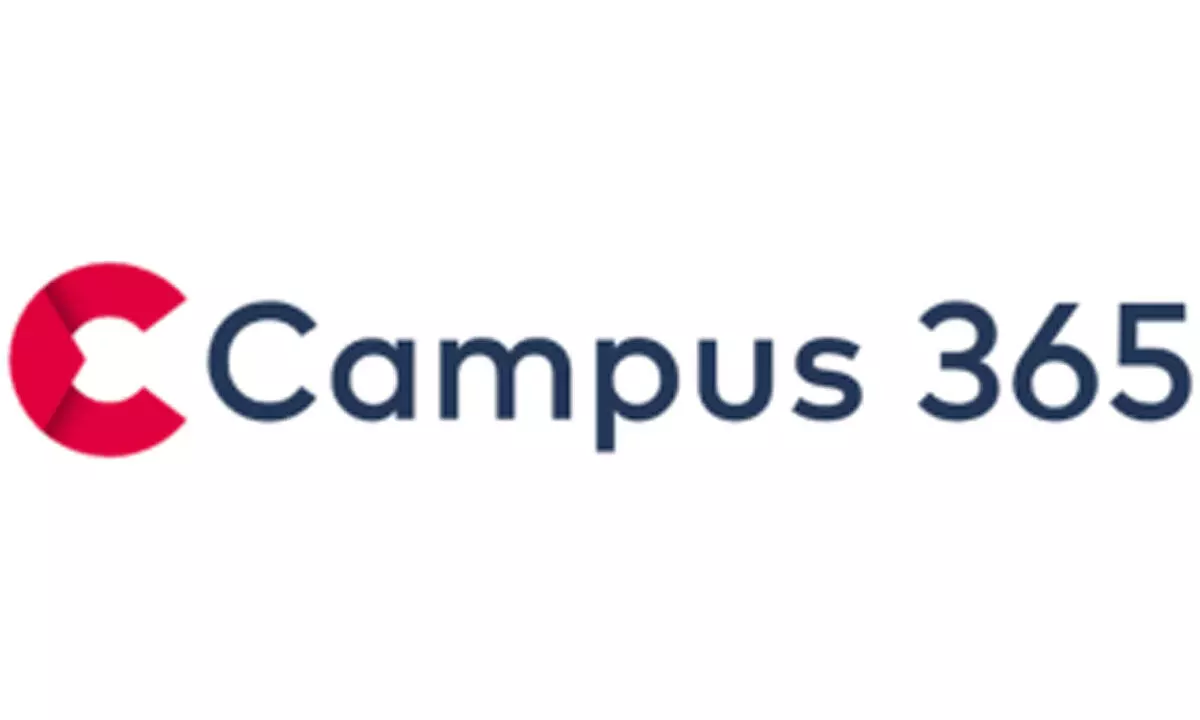Campus 365 lets institutes focus on student growth and education - Mayank Singh, Co-Founder & CEO

Campus 365 lets institutes focus on student growth and education - Mayank Singh, Co-Founder & CEO
Campus 365 helps educational institutions deliver effective and engaging learning experiences to their students. Campus 365 uses technology innovations to enhance the learning experience and improve student outcomes.
Established in 2017, Campus 365 is a technology and operations start-up that collaborates with educational institutions to optimize their end-to-end operations. Campus 365 offers a completely cloud-based solution that is robust and scalable. Their core offering is a highly customizable ERP platform that aligns with the operational workflows of their customers. Their services include automatic attendance, GPS tracking, timetable automation for students and teachers, online content to enhance student and teacher knowledge, graphical reports to analyze student learning, and easy online fee collection and reconciliation.
In an exclusive interview with The Hans India, the brain behind Campus 365, Mr Mayank Singh, tells Kahekashan about the journey of Campus 365 from a start-up to a company that serves colleges, schools, and coaching facilities not only in India but also in the United States, United Kingdom, South Africa, Nepal, Ghana, Nigeria, Zimbabwe, Bangladesh, and Australia.
Mayank Singh, Co-Founder & CEO of Campus 365
Mayank Singh is the inspiration for all technological advancements that make learning more individualised and interesting and education more automated, which improves student learning results. By revamping educational institutions in Tier II, III, and IV cities, where the majority of Indians live, he hopes to democratise outstanding learning. He is adamant that every child should have access to a top-notch education, regardless of their family's financial situation or place of birth.
Campus 365 Mission
The company's mission is to increase technology adoption in educational institutions. They engage closely with customers throughout their journey to understand their challenges and help overcome them. Their ethos of "Constant Innovation" drives them to collaborate with multiple solution providers in the Ed-Tech industry, creating an ecosystem of solutions that customers can use to improve teaching and learning practices in their institutions.
The goal of Campus 365 is to automate daily operations in educational institutes and reduce the time and money spent on manual operations. This allows institutes to focus on their strengths, namely student growth and education. The company provides effective tracking and management of operations, generating value for various stakeholders such as principals, HODs, institute owners, teachers, students, and parents.
How is Campus 365 helping customers deliver relevant outcomes through the adoption of the company's technology innovations?
Campus 365 helps educational institutions deliver effective and engaging learning experiences to their students. Campus 365 uses technology innovations to enhance the learning experience and improve student outcomes.
Campus 365 helps its customers deliver relevant outcomes by providing a range of tools and features that support the learning process. For example:
1. Personalized Learning: Campus 365 allows instructors to initiate personalized learning paths for each student based on their individual learning needs, preferences, and performance. This approach ensures that students are receiving the right content and resources at the right time, which leads to better outcomes.
2. Collaborative Learning: Campus 365 enables collaboration among students, instructors, and other stakeholders through features like discussion forums, chat, and video conferencing. This encourages active learning, promotes teamwork, and improves communication, which results in better outcomes.
3. Data-Driven Insights: Campus 365 uses data analytics to provide insights into student performance, engagement, and progress. This information helps instructors identify areas where students are struggling, adjust their teaching strategies, and provide targeted support to improve outcomes.
4. Seamless Integration: Campus 365 integrates with various other educational tools and platforms, such as learning management systems, assessment tools, and student information systems. This integration streamlines the learning process, reduces administrative burdens, and allows instructors to focus on delivering quality instruction.
Campus 365's technology innovations and features are designed to support student learning and improve outcomes. By adopting the platform, customers can deliver personalized, collaborative, and data-driven learning experiences that help students achieve their full potential.
How are schools and other institutions coping with the changes in technology as the traditional methods of learning are vanishing?
Schools and other educational institutions are adapting to the changes in technology as the traditional methods of learning are evolving. Some ways in which they are coping with these changes include:
1. Adopting Digital Learning Platforms: Schools and other institutions are adopting digital learning platforms like Campus 365 to provide students with a more engaging and interactive learning experience. These platforms offer a range of features like personalized learning, collaborative learning, and data-driven insights, which support student learning and improve outcomes.
2. Providing Professional Development Opportunities: Educational institutions are providing teachers and staff with professional development opportunities to help them stay up-to-date with the latest technology and teaching methods. This includes training on how to use digital learning platforms, how to integrate technology into the classroom, and how to teach effectively in an online or blended learning environment.
3. Investing in Technology Infrastructure: Schools and other institutions are investing in technology infrastructure to support digital learning. This includes upgrading their networks and hardware, providing devices like laptops and tablets to students, and ensuring that their classrooms and facilities are equipped with the necessary technology.
4. Embracing Hybrid Learning: Educational institutions are embracing hybrid learning, which combines in-person and online learning. This approach allows students to access course materials and collaborate with their peers and instructors from anywhere while still maintaining a sense of community and engagement.
These changes are helping to ensure that students receive a high-quality education that prepares them for success in an increasingly digital world.
How is the global adoption of a tech-first ethos changing education?
The global adoption of a tech-first ethos is changing education in several ways:
1. Increasing Access to Education: Technology is making education more obtainable to students around the world. With digital learning platforms and online resources, students can access educational content from anywhere, at any time, as long as they have an internet connection.
2. Personalizing Learning: Technology is allowing for more personalized learning experiences. With tools like adaptive learning algorithms and data analytics, educators can tailor learning experiences to individual student needs and abilities.
3. Encouraging Collaboration: Technology is enabling greater collaboration among students and teachers. Digital learning platforms allow students to work together on projects and assignments, even if they are in different parts of the world. Teachers can also collaborate to share resources and ideas.
4. Enhancing Engagement: Technology is making education more engaging for students. With interactive learning materials, multimedia content, and gamification, students are more motivated to learn and participate in the learning process.
5. Developing New Skills: Technology is helping to develop new skills that are necessary for the 21st-century workforce. Students are learning how to use technology tools, collaborate with others remotely, and navigate digital environments.
What opinions do tier 1 and tier 3 towns have about the development of technology in education? Is it beneficial for the students?
Many people in tier 1 towns view technology as a positive force in education. They believe technology can enhance the learning experience, provide more personalized learning opportunities, and help prepare students for the digital workforce. They also see technology as a way to bridge the gap between urban and rural education and increase access to educational resources.
In tier 3 towns, opinions about the development of technology in education are more varied. Some people view technology as a way to overcome educational inequities and provide access to educational resources that might not otherwise be available. Others are more skeptical and express concerns about the quality of online education, the potential for technology to increase social isolation, and the lack of access to reliable internet and technology infrastructure in rural areas.
While some studies suggest that technology can improve student achievement, other studies show mixed or inconclusive results. Some educators and parents worry that too much reliance on technology can negatively impact students' social-emotional development and critical thinking skills.
What measures should institutions take to improve skill development since upskilling is anticipated to be popular in the coming years?
As upskilling is anticipated to be popular in the coming years, institutions should take measures to improve skill development. Here are some suggestions that I feel should be considered:
1. Identify the skills that are in demand: Institutions should research and identify the skills that are in demand in their industry or region. This will help them to tailor their training programs to meet the needs of employers and ensure that their graduates are prepared for the workforce.
2. Develop relevant training programs: Institutions should develop relevant training programs that are designed to help students develop the skills that are in demand. This could involve creating new courses, updating existing courses, or partnering with employers to offer apprenticeships or work-based learning opportunities.
3. Use technology to enhance learning: Institutions should leverage technology to enhance the learning experience. This could involve using digital learning platforms, online resources, and multimedia content to create more engaging and interactive learning experiences.
4. Provide flexible learning options: Institutions should provide flexible learning options that allow students to learn at their own pace and schedule. This could involve offering online or blended learning options or creating programs that can be completed on a part-time or accelerated basis.
5. Offer career services: Institutions should offer career services to help students identify job opportunities and generate the skills and tools they need to succeed in their careers. This could involve providing career counselling, resume and interview preparation, and networking opportunities with employers.
Campus 365 Vision
Campus 365 aims to reach an annual revenue of 15 Cr based on their projections and annual growth. In five years, they aim to become an ecosystem where new users can easily plug in. By January 2026, Campus 365 intends to onboard 15K institutions from India, Saudi Arabia, Africa (Nigeria, Ghana, and Zambia), and Singapore from a cumulative TAM of 2Mn Institutions and SAM of 520K Institutions.
The growth and expansion that Campus 365 has shown in the education sector is impressive. Despite being one of 800+ ERP players in the country when they started, they are now among the top 3 highest-selling ERPs, competing with some of the established market giants.

















